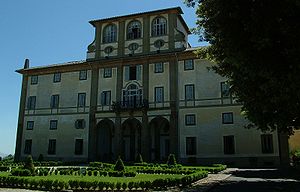
Villa Rufinella
Encyclopedia


Villa
A villa was originally an ancient Roman upper-class country house. Since its origins in the Roman villa, the idea and function of a villa have evolved considerably. After the fall of the Roman Republic, villas became small farming compounds, which were increasingly fortified in Late Antiquity,...
in Frascati
Frascati
Frascati is a town and comune in the province of Rome in the Lazio region of central Italy. It is located south-east of Rome, on the Alban Hills close to the ancient city of Tusculum. Frascati is closely associated with science, being the location of several international scientific...
, Italy
Italy
Italy , officially the Italian Republic languages]] under the European Charter for Regional or Minority Languages. In each of these, Italy's official name is as follows:;;;;;;;;), is a unitary parliamentary republic in South-Central Europe. To the north it borders France, Switzerland, Austria and...
.
Villa Rufinella is situated highest of the villas on the hill above the town of Frascati. It was built by Alessandro Ruffini, bishop of Melfi, in 1578, but during its history, the proprietors have made changes in different parts of it. In 1773 the villa became property of the pope. Architect Luigi Vanvitelli
Luigi Vanvitelli
Luigi Vanvitelli was an Italian engineer and architect. The most prominent 18th-century architect of Italy, he practiced a sober classicizing academic Late Baroque style that made an easy transition to Neoclassicism.-Biography:Vanvitelli was born at Naples, the son of a Dutch painter of land and...
, commissioned by the Jesuits, gave the building its present appearance.
In 1804 Pope Pius VII
Pope Pius VII
Pope Pius VII , born Barnaba Niccolò Maria Luigi Chiaramonti, was a monk, theologian and bishop, who reigned as Pope from 14 March 1800 to 20 August 1823.-Early life:...
sold the Villa to prince Lucien Bonaparte
Lucien Bonaparte
Lucien Bonaparte, Prince Français, 1st Prince of Canino and Musignano , born Luciano Buonaparte, was the third surviving son of Carlo Buonaparte and his wife Letizia Ramolino....
during his self-imposed exile in Rome. Prince Lucien started the first excavations in the area of the villa and in the territory of Tusculum
Tusculum
Tusculum is a ruined Roman city in the Alban Hills, in the Latium region of Italy.-Location:Tusculum is one of the largest Roman cities in Alban Hills. The ruins of Tusculum are located on Tuscolo hill—more specifically on the northern edge of the outer crater ring of the Alban volcano...
, sending many of the artifacts found to Paris to be sold on the antiques market. In 1817 a group of bandits of the famous band of robber Gasperoni, commanded by Tommaso Transerici, tried to kidnap the Prince Lucien during one of his parties in the gardens. Instead of the Prince, the bandits kidnapped one of his guests, an artist named Charles de Chatillôn, who softened the bandits by painting portraits of them during his captivity. The Prince was so annoyed by the attack that he sold the villa soon thereafter.
In 1820 the villa was passed into the possession of Princess Maria Anna of Savoy. Queen Maria Christina of Naples and Sicily, wife of Charles Felix of Sardinia
Charles Felix of Sardinia
Charles Felix was the Duke of Savoy, Piedmont, Aosta and King of Sardinia from 1821 to 1831.-Early life:...
, inherited the villa bequeathed to the Princess Maria Anna, and lived there for long periods until 1843. In 1834, to commemorate his stay as a guest in the villa, Italian poet Giuseppe Gioachino Belli wrote a sonnet in Roman dialect called "La Rufinella". After 1848 the Villa became the property of King Vittorio Emanuele II, who sold it to the Lancellotti family.
The villa suffered heavy damage during World War II
World War II
World War II, or the Second World War , was a global conflict lasting from 1939 to 1945, involving most of the world's nations—including all of the great powers—eventually forming two opposing military alliances: the Allies and the Axis...
(1943–1944). Since 1966 the Villa Rufinella has been owned by the Salesians of Don Bosco
Salesians of Don Bosco
The Salesians of Don Bosco is a Roman Catholic religious order founded in the late nineteenth century by Saint John Bosco in an attempt, through works of charity, to care for the young and poor children of the industrial revolution...
, a Roman Catholic religious society: they have restored the building and turned it into a conference hotel.
See also
- FrascatiFrascatiFrascati is a town and comune in the province of Rome in the Lazio region of central Italy. It is located south-east of Rome, on the Alban Hills close to the ancient city of Tusculum. Frascati is closely associated with science, being the location of several international scientific...
- Luigi VanvitelliLuigi VanvitelliLuigi Vanvitelli was an Italian engineer and architect. The most prominent 18th-century architect of Italy, he practiced a sober classicizing academic Late Baroque style that made an easy transition to Neoclassicism.-Biography:Vanvitelli was born at Naples, the son of a Dutch painter of land and...
- Lucien BonaparteLucien BonaparteLucien Bonaparte, Prince Français, 1st Prince of Canino and Musignano , born Luciano Buonaparte, was the third surviving son of Carlo Buonaparte and his wife Letizia Ramolino....

